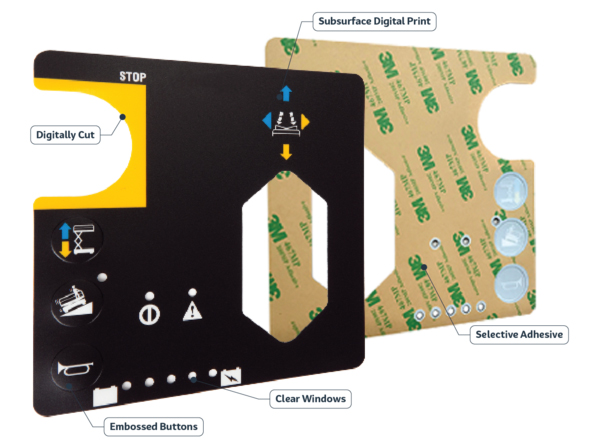In industries such as medical, automotive, industrial, and consumer electronics, user interfaces often rely on graphic overlays as the critical touchpoint between humans and machines. A graphic overlay is the visible top layer of a device’s control panel; it labels and protects the underlying components and serves as the “face” of the product, shaping first impressions.
Designing a custom overlay requires balancing material choices, environmental demands, functionality, and aesthetics. This guide highlights key considerations to ensure your overlay is durable, user-friendly, and aligned with your brand.
Understanding Graphic Overlays
Graphic overlays are thin, printed layers used on the surface of equipment to display information, guide users, and protect internal controls. Found on everything from medical monitors to industrial machines, overlays serve both functional and aesthetic purposes.
They simplify complex operations, offer tactile or visual feedback, and reinforce a brand’s identity. Because they are the first point of interaction between users and devices, a well-designed overlay greatly improves usability, safety, and product perception.
Key Considerations for Custom Graphic Overlays
When designing custom graphic overlays, several important factors come into play. Let’s break them down clearly
1. Material Selection: Polycarbonate vs. Polyester
Choosing the right material is key to performance.
- Polycarbonate is great for vibrant graphics, clarity, and impact resistance, but is less chemically resistant.
- Polyester is better for high durability, chemical resistance, and long flex life, making it ideal for demanding environments. Your product's use case will guide the right material choice.
2. Environmental Considerations
Think about where the device will operate:
- Temperature extremes, UV exposure, chemical cleaners, and moisture can all damage overlays.
- Use UV-stable materials outdoors and chemical-resistant films for medical or industrial settings.
Designing with the environment in mind ensures longevity and reliability.
3. Durability and Longevity
Overlays should last the lifetime of the device.
- Sub-surface printing protects graphics from wear.
- Hard coatings resist scratching.
- Flexible materials endure millions of presses without cracking.
Choosing durable materials and finishes prevents premature failure.
4. Design and Aesthetic Considerations
A custom overlay should match both functionality and visual appeal:
- Use precise color matching for brand consistency.
- Select matte or glossy finishes based on lighting conditions.
- Include backlit windows or dead-front graphics for modern, sleek interfaces.
Good design ensures users can quickly understand and operate the device.
5. Functional Features and Enhancements
Enhance usability with smart design features:
- Embossing raises keys or icons for easier navigation by touch.
- Metal or poly domes add a “click” feel for tactile feedback.
- Display windows allow clear viewing of indicators or screens.
Functional features make the interface intuitive without adding complexity.
6. Adhesive and Mounting Options
A reliable adhesive keeps overlays securely in place:
- Choose adhesives based on the surface material (metal, plastic, glass).
- Consider environmental factors like moisture, heat, and surface texture.
Proper adhesive selection prevents peeling, lifting, or shifting during product use.
7. Industry and Regulatory Requirements
Depending on your industry, your overlay may need to meet specific standards:
- Medical overlays must endure strong disinfectants and may need antimicrobial coatings.
- Industrial and automotive overlays might require UL ratings or flame resistance.
Design with compliance in mind to avoid delays and ensure safe performance.
8. Partnering with the Right Manufacturer
An experienced manufacturing partner is invaluable:
- They ensure materials, adhesives, and finishes meet your needs.
- They help identify risks early and streamline production.
Choosing experts ensures high-quality overlays and smooth project delivery.
Design Better Products with Graphic Overlays
A well-designed graphic overlay enhances a product’s appearance and improves its usability, safety, and longevity. By focusing on the right materials, environmental needs, design elements, and regulations—and partnering with an experienced manufacturer—you set the foundation for a better user experience and a longer-lasting product.


